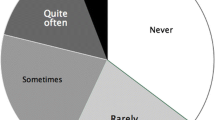Abstract
Grooming among adult and older juvenile females in a wild group of blue monkeys (Cercopithecus mitis stuhlmanni) is analyzed and related to agonistic behavior. Both grooming and agonistic behavior were less frequent than would be expected in baboon and macaque groups. Fair shares of grooming were given and taken, both within and between interactions, in amost dyads, and all females were seen to groom with at least half the others. The reciprovity of grooming was its most outstanding feature. There was no evidence that grooming was preferentially directed at kin. Frequent grooming partnerships fell into two clusters, one of which ranked higher than the other. We suggest that grooming throughout the group helps to establish a coherent team of females which effectively, defends its territory in daily encounters at the boundaries with neighboring groups.
Similar content being viewed by others
References
Butynski T. M. (1990). Comparative ecology of blue monkeys (Cercopithecus mitis) in high-and low-density subpopulations.Ecol. Monogr. 60:1–26.
Coelho, A. M., Turner S. A., and Bramblett, C. A. (1983). Allogrooming and social status: An assessment of the contribution of female behavior to the social organization of hamadryas babboons (Papio hamadryas).Primates 24:184–197
Cords, M. (1987).Mixed species associations of Cercopithecus monkeys in the Kakamega Forest, Kenya, University of California Publications in Zoology 117, UC Press, Berkeley
Cords M., and Rowell, T. E. (1986). Group fission in Blue monkeys of the Kakamega Forest, Kenya.Folia, Primatol. 46:70–82.
de Waal, F. B. M., and Luttrell, L. M. (1989). Toward a comparative socioecology of the genusMacaca: different dominance styles in rhesus and stumptail monkeys.Am. J. Primatol. 19:83–109.
de Waal, F. B. M., and Yoshihara, D. (1983). Reconciliation, and redirected aggression in rhesus monkeys.Behaviour 85:225–241.
Dunbar, R. I. M., and Sharman, M. (1984). Is social grooming altruistic?Z. Tierpsychol. 64:163–173.
Ehardt, C. (1988). Absence of strongly kin-preferential behavior by adult female sooty mangabeys (Cercocebus atys).Am. J. Phys. Anthropol. 76:233–243.
Fairbanks, L. A. (1980). Relationships among adult females in captive vervet, monkeys: Testing a model of rank-related attractiveness.Anim. Behav. 28:853–859.
Kawai, M. (1958). On the system of social ranks in a natural troop of Japanese monkeys. I. Basic and dependent rank.Primates 1:111–130.
Kurland, J. A. (1977).Kin Selection in the Japanese Monkey Contributions to Primatology 12, S. Karger, Basel.
Lindburg, D. G. (1973). Grooming behavior as a regulator of social behavior in rhesus monkeys. In Carpenter, C. R. (ed.),Behavioral Regulation of Behavior in Primates, Bucknell UP, Lewisburg, PA.
Marler, P. (1965). Communication by monkeys and apes. In De Vore, I. (ed.),Primate Behavior, Holt, Rinchart and Winston, New York, pp. 544–584.
Missakian, E. A. (1974). Mother-offspring grooming relations in rhesus monkeys.Arch. Sex. Behav. 3:135–141.
Rowell, T. E. (1966). Hierarchy in the organization of a captive baboon group.Anim. Behav. 14:430–443.
Sade, D. S. (1965). Some aspects of parent-offspring and sibling relationships in a group of rhesus monkeys, with a discussion of grooming.Amer. J. Phys. Anthropol. 23:1–18.
Sade, D. S. (1967). Determinants of domiance in a group of free-ranging rhesus monkeys. In Altmann, S. A. (ed.),Social Communication among Primates, University of Chicago Press, Chicago, pp. 99–114.
Sade, D. S. (1972). Sociometrics ofMacaca mulatta. I. Linkages and cliques in grooming matrices.Folia primatol. 18:196–223.
Seyfarth, R. M. (1976). Social relationships among adult female baboons.Anim. Behav. 24:917–938.
Seyfarth, R. M. (1977). A model of social grooming among adult female monkeys,J. Theor. Biol. 65:671–698.
Seyfarth, R. M. (1980). The distribution of grooming and related behavior among adult female vervet monkeys.Anim. Behav. 28:798–813.
Silk, J. B. (1982). Altruism among femaleMacaca radiata, explanations and analysis of patterns of grooming and coalition formation.Behaviour 79:162–188.
Stammbach, E. (1978). On social differentiation in groups of captive female hamadryas baboons.Behaviour 67:322–338.
Author information
Authors and Affiliations
Rights and permissions
About this article
Cite this article
Rowell, T.E., Wilson, C. & Cords, M. Reciprocity and partner preference in grooming of female blue monkeys. International Journal of Primatology 12, 319–336 (1991). https://doi.org/10.1007/BF02547615
Received:
Revised:
Issue Date:
DOI: https://doi.org/10.1007/BF02547615




